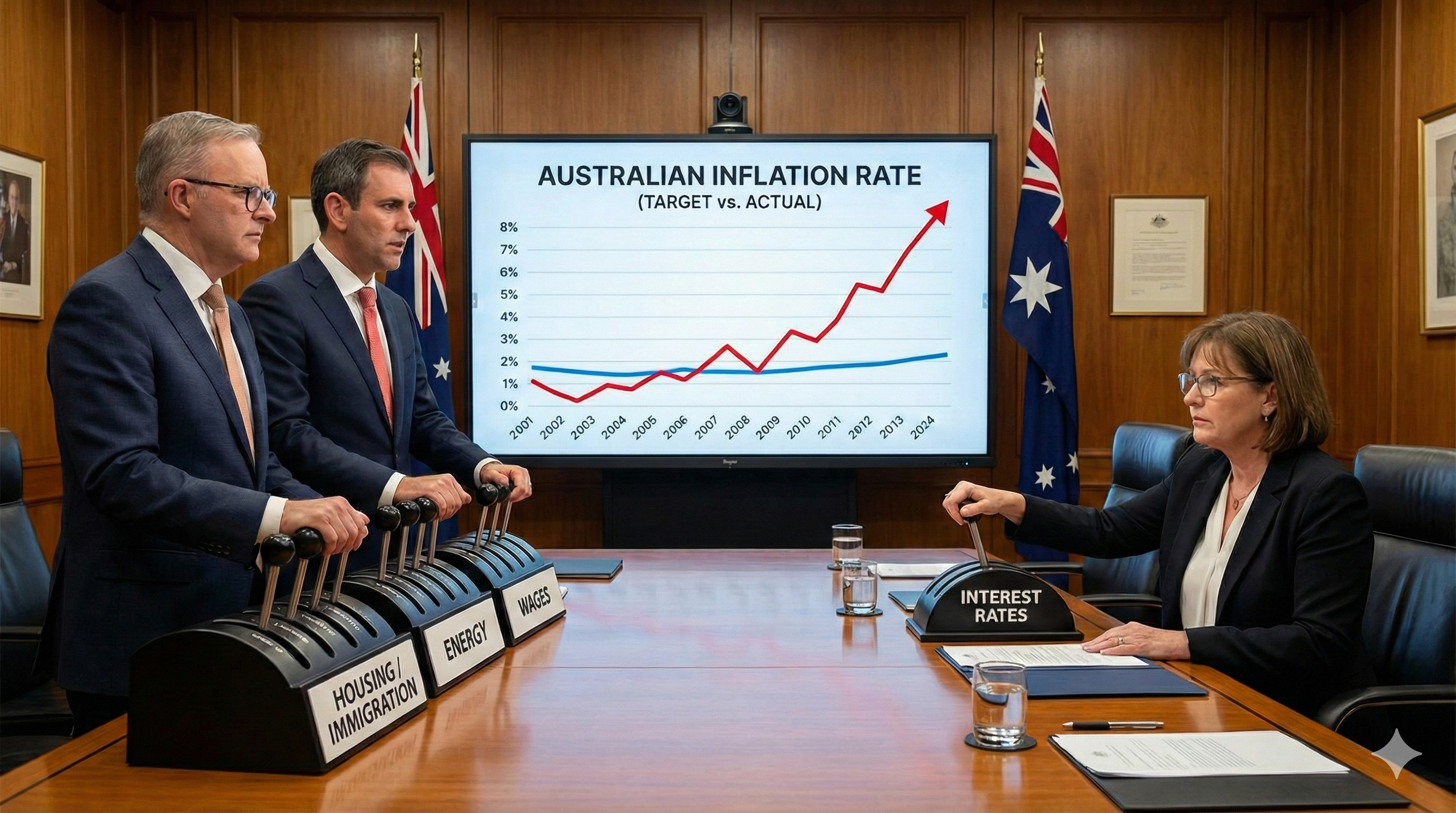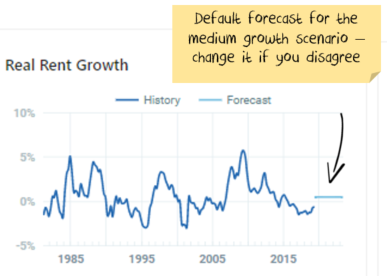Residential real estate Forecasting Factors
We look at four key factors that constrain how high or low property prices can go. These are the four factors you can use to forecast residential real estate prices in our Australian property market calculator:
- Mortgage Payments to Rent: comparing the cost of a mortgage with the cost of renting the same house. Using this ratio to constrain residential real estate prices, we assume that people will prefer to rent when the ratio gets high rather than buy.
- Mortgage Payments to Wages: assuming when the ratio gets high, people rent because they cannot afford to buy.
- Property Prices to Wages: assuming when the ratio gets high, people rent because they cannot save enough money to afford a deposit. We treat this as less important than the above two ratios.
- Rental Yield: Rental yield is the annual rent divided by the property price. By using this ratio to forecast prices, you are assuming when the ratio gets low investors will not buy property as they are not getting a return that is high enough.
[tabgroup title="More information on real estate forecasting factors" style="tabs" nav_size="small"] [tab title="Mortgage Cost to Rent"]
This is a comparison of the cost of a mortgage with a 20% deposit, compared to the cost of renting the same house. By using this ratio to value house prices, we assume when the ratio gets high that people will prefer to rent rather than buy.
The consequence will be either (1) residential real estate prices will fall until it becomes more attractive for people to buy or (2) the Reserve Bank will lower interest rates and so the cost of a mortgage will decrease.
The benefit of using this ratio is it provides insight into the decisions both homeowners and investors are making. When the cost of a mortgage is cheaper than renting for a homeowner, or an investor can see their mortgage paid for by the rent, then prices tend up. Also, rent is a relatively stable series:

i.e. rents tend to go up a little more or a little less than inflation
The problem with using this series is that you can get significant changes in the series as central banks raise interest rates to slow the economy and then cut them to stimulate. It also ignores wage growth – strong wage growth supports higher prices. It ignores the higher deposits needed with higher house prices.
[/tab] [tab title="Mortgage Cost to Wages"]
By using this ratio to examine residential real estate valuation, you are assuming when the ratio gets high, people rent because they cannot afford to buy. The consequence will be either:
- property prices will fall until it becomes affordable for people to purchase or
- wages will rise until it becomes affordable for people to buy.
The benefit of using this ratio is that it provides a realistic impression of the decision many homeowners make: they spend as much as they can afford. Also, wages are even more stable than rents:

i.e. wages tend to go up a little more than inflation each year without much variation.
The problem with using this series is the same as the above: you can get significant changes in the series as central banks raise interest rates to slow the economy and then cut them to stimulate.
[/tab] [tab title="Property price to wages"]
By using this ratio to look at residential real estate valuation, you are assuming when the ratio gets high people rent because they cannot save enough money to afford a deposit. The consequence will be either:
- real estate prices will fall until it becomes more affordable for people to buy or
- wages will rise until it becomes affordable for people to buy.
The benefit of using this ratio is that it provides an additional dimension to the 2nd factor. Homeowners spend as much as they can afford, but they need to be able to save the deposit. This helps to indicate whether they can.
The problem with using this series is that it doesn’t incorporate falling interest rates or changes in rent. For this reason, I tend not to use this as my primary forecasting method, more of an additional check on the outcomes.
[/tab] [tab title="Rental Yield"]
Rental yield is the annual rent divided by the property price. By using this ratio to look at residential real estate valuation, you are assuming when the ratio gets low investors will not buy property as they are not getting a return that is high enough. The consequence will be either:
- house prices fall until it becomes more attractive for investors to buy or
- rents will rise until it becomes attractive for investors to buy.
The benefit of using this ratio is that it provides a better indication of investor returns.
The problem with using this series is that it is hard to forecast. There is (probably?) a limit to how low yields can go, especially as there are only a few more rate cuts left. I would argue that the net (i.e. after subtracting costs) yield is a better indicator, but this is much harder to observe and requires guesswork. Another alternative would be the yield relative to something like a ten-year government bond. This would show the return for investors relative to other opportunities. However, if you wanted to forecast property prices that way, your first step would be predicting the 10-year bond rate. And that is making forecasting harder rather than easier. For these reasons, I tend not to use this as my main forecasting method. It is more of a supplementary check on the outcomes.
[/tab] [/tabgroup]
Sources:
Nucleus Wealth has compiled this data using a range of different sources.
We use Domain for more recent data quarterly property prices and rents, cross-checked with SQM to fill any short-term moves. Older information is from Rismark and the Australian Bureau of Statistics to fill time series.
For economic data, we use either Reserve Bank of Australia or Australia Bureau of Statistics data. For older data, we have had to estimate some factors due to differing definitions over time.
Follow @DamienKlassen on Twitter or Linked In
The information on this blog contains general information and does not take into account your personal objectives, financial situation or needs. Past performance is not an indication of future performance. Damien Klassen is an authorised representative of Nucleus Wealth Management, a Corporate Authorised Representative of Nucleus Advice Pty Ltd - AFSL 515796.







